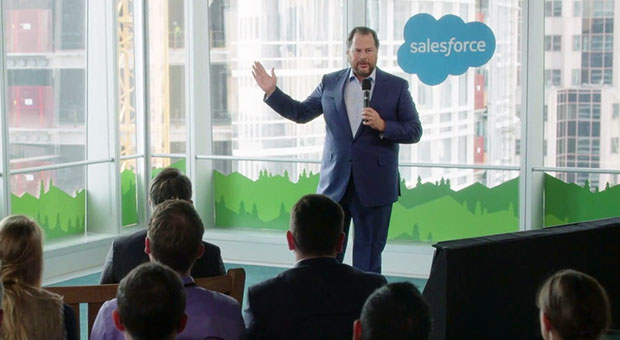Salesforce will be celebrating its 20th birthday on March 8. Where did those decades go? “Time flies like an arrow,” said Groucho. “Fruit flies like a banana.”
There it is.
A respectable chunk of the analyst community that follows Salesforce converged last week in San Francisco inside the company’s cavernous new headquarters to hear about its plans for the year ahead. I’ll get to some of the non-NDA ideas floating around the sessions momentarily, but first some impressions of the first (or last?) 20 years.
Fitting the Need
In many ways, Salesforce has executed a typical and nearly flawless grassroots maneuver of the kind explained by gurus like Geoffrey Moore and Clay Christenson. It entered the market late, after Siebel was already a billion-dollar company, but its entry was not of an also-ran. From the beginning, Salesforce positioned itself as fundamentally different because it was what would become known as a “Software as a Service,” or SaaS, company.
Competing with an established player can be hard. Initially, the Salesforce app comprised just four tabs, compared to Siebel’s many. In fact, Marc Benioff said they were so numerous they were useless. That’s nothing you’d hear from Salesforce today, with its numerous clouds. However, Salesforce was selling something that every company wanted at that point and it had little to do with the merits of its CRM — quick delivery and low costs.
You see, Salesforce arrived at the start of the century, just as the smoke was clearing from the traumatic change of financial systems to accommodate four-digit date formats.
Conventional CRM in those days was largely a custom programming market, and implementation cost metrics often stipulated that the total cost of ownership in CRM would be three to four times the software costs. They weren’t wrong, and there was a kind of fatalism, at least among large companies, that that was the way things would be.
You can’t grow a market or a category like that. If prices had not come down, CRM would have become a not-very-good major corporation plaything. Prices had to come down, and functionality had to expand in order to get CRM into the hands of medium-size companies and even those smaller. SaaS, with its very low cost of ownership, fit the need precisely.
Commoditization of IT
Salesforce changed that equation and in so doing gave itself and multiple other dot-com companies running room. Still, it was amazing to me even then that the CEOs of most of the other CRM competitors offering SaaS services failed to understand the importance of what they had. Most simply regarded SaaS as another delivery mechanism, rather than the revolutionary commoditization of IT that the industry badly needed.
IT in the earliest decade of the century was ripe for commoditization. It was traditional and highly manual. There were no smartphones or social media then, and analytics was a failed idea from the 1990s in need of greater CPU horsepower and data storage before it could take on its natural role.
Much of this comes together in one observation. If you wanted to brief me, or any analyst, about your company, products and strategies, in the hope that I’d write about you, it was necessary to fly to Boston to do that in person. There were no products like WebEx yet. It was a long time ago if you’re basing your analysis on such things.
So, into that milieu Salesforce launched in 2000, after a year of software development led by cofounder Parker Harris, but what’s interesting is that the company hasn’t changed that much in the intervening decades. Instead, the industry has continued to play catch-up over numerous product cycles that have included basic SaaS, social media, mobility, platforms, customer journeys, analytics and machine learning.
Corporate Social Responsibility
Always lurking in the background has been the company’s famous 1:1:1 approach to corporate social responsibility. It still donates 1 percent of its people’s time, its equity and product to charity. Most interestingly, more than 2,000 companies have taken the hint and developed similar programs. They aren’t all small companies, either. Google instituted such a program before its IPO, and on the day it went public automatically spun up a large charity.
Lately Salesforce has described the four pillars of its business as trust, customer success, innovation and equality, which neatly ties together its attitudes about customers, employees, the community, and its responsibility to deliver innovative products, which brings us full circle to last week.
Commoditization of IT hasn’t ended. Salesforce might have taken advantage of a nascent trend at its inception, but the need already was pronounced. Understanding that trend in relation to the IT industry is important, in part because it seems like cloud computing is now the thing that’s commoditizing.
Closing the Frontier
My observation today is that not only Salesforce but most of the industry is built out. That’s far from saying there’s nothing left to do, though. It’s more like closing the American frontier in 1890 — there’s no more frontier, but there’s still plenty to be done internally.
In Salesforce’s case, as well as much of IT, we’ve entered an era of efficiency and effectiveness, meaning that we’ve produced various automations and our focus now is optimizing them.
Fair enough — but this also means that the importance of product announcements and making release dates begins to recede into the background. What takes prominence are the services needed to help customers to be successful, and we’ve seen Marc Benioff harping on this aspect repeatedly. So rather than big news items, we’ll be on the lookout for more individual customer accomplishments.
For example, for several years already, Salesforce has been edging toward the position of change agent and corporate culture transformation maven, and you see it in the discussion of digital disruption. No one buys digital disruption, there are no products labeled as such, just as there are no cans of whoop-ass (a technical term) on store shelves that you can pour on an IT problem.
If you go back to the company’s four pillars — trust, customer success, innovation and equality — you realize that only one is about technology. The others are about how you encourage people to take the leaps necessary to achieve digital prowess, to have the courage to become data-driven, and to make better business decisions. It’s culture change.
That’s what I think last week was about, and I think one data point neatly encapsulates this. They told us that this fiscal year 55 percent of the sales team will be focused on industries like insurance, financial services, healthcare and more, and that number is trending. Working that angle, you can expect more things like My Trailhead, a learning system that can deliver knowledge about anything to a user that’s relevant to a business process.
My Two Bits
Despite its great success, Salesforce is not the CRM industry; it has revenues of US$10 billion in a market that generates $80-ish billion in revenues. In Salesforce’s history, though, you can discern all of the industry’s major inflection points.
Looking at CRM today you can conclude that it’s mature, and that major systems are already in place. However, there’s still ample room for growth, and in a mature market you typically see vendors working to make their products easier to use through more service offerings, such as in industry versions.
In line with this, CRM will continue enabling users to be more effective. This enablement will become increasingly fine-grained as the vendors reach into industries with detailed solutions for specific business problems.
I think the next big milestone for CRM will be inter-vendor inter-process communication — something beyond integration. It will take the whole industry to solve that challenge, just as it took the whole industry to come up with SQL and the relational database. Based on what I saw last week, Salesforce already is working on it.

























































